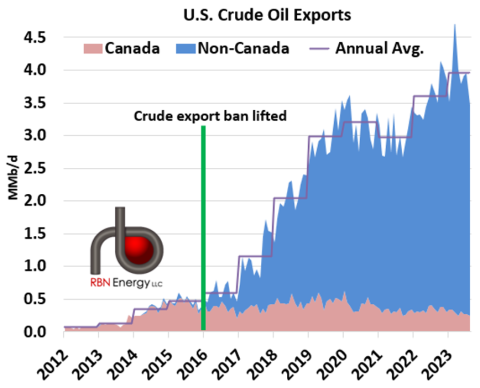There’s a lot going on in the US crude markets these days. Exports are underway. Midland WTI can now be delivered to Brent (but only if it meets specifications). Pipelines from the Permian to Corpus Christi are maxed out, driving incremental production in Houston. The price differential between WTI in Midland and Houston is approaching zero. And the value of heavy Western Canadian Select (WCS) delivered to the US continues to bounce around. Are they random and unrelated events in the peculiar physical US crude market, or are they logical developments linked by the economics of refinery preferences, quality changes, export demand and logistics? As you might expect, we think it’s the latter. Believe it or not, crude oil markets sometimes behave rationally and occasionally even predictably. That’s what we explore in today’s RBN blog.
Beyond the Blogosphere! Join RBN’s Rusty Braziel and Marty King and Link Data Services’ Scott Nelson for our North American Crude Oil Markets Let’s Get Physical webcast on Tuesday, August 29 at 2:30 p.m. central To register, click here.
It will come as no surprise to anyone familiar with the RBN blogosphere that one of the main drivers of the North American crude oil market over the past seven years has been exports. As shown in Figure 1, exports have increased from a rounding error before 2015, when the ban on exporting to non-Canadian countries was lifted, to nearly 4 Mb/d as of year. In addition to the impact of COVID-19 2020-21, the increase has been strong and steady. About 9% of those export barrels still go to Canada (pink layer in the chart), with the rest going to foreign markets (blue layer). With US production up to 12.7 Mb/d according to the most recent EIA statistics, this puts exports at 31% of barrels produced. Of course, the US still imports somewhere in the 6-7 MMb/d range, but that’s all sour (higher sulfur) medium to heavy crude than the complex US refineries in PADD 2 (Midwest) and PADD 3. (Gulf Coast) can be broken down into valuable refined products, and 60% comes from Canada, while US exports are almost exclusively light, sweet (low-sulfur) shale crudes that generally fit much better in overseas refineries than in US

Figure 1. US crude oil exports. Source: EIA


